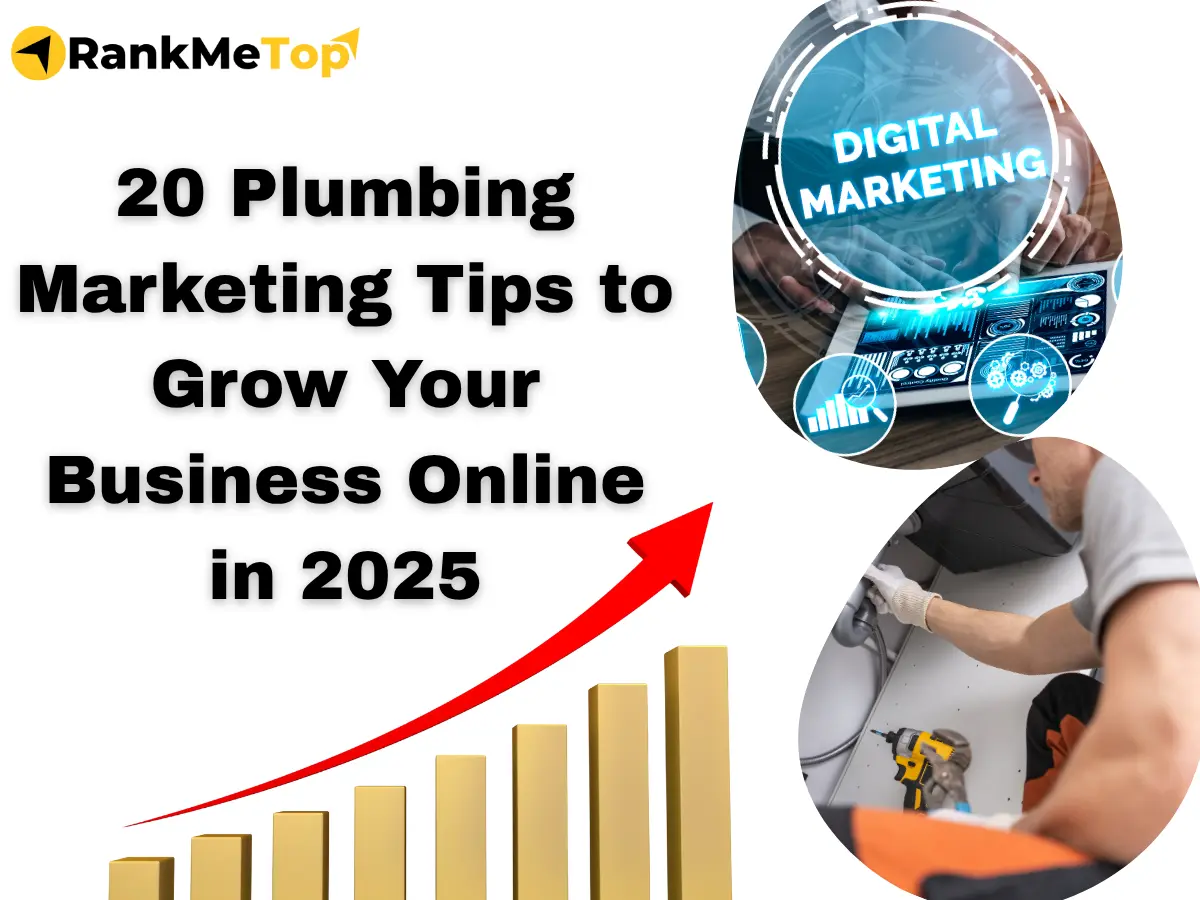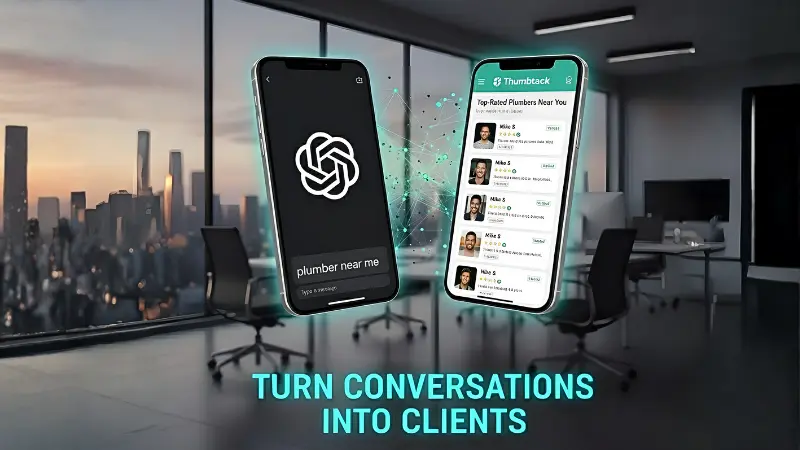Thumbtack Partners with OpenAI to Bring Home Service Hiring Directly into ChatGPT
Leading home services platform Thumbtack is set to redefine local hiring with a new...

Fixing leaky pipes, clearing clogged drains, or repairing broken water lines is natural for a professional plumbing business. But scaling a plumbing company requires more than skill with pipes and wrenches. It demands a set of digital marketing strategies, especially as the world moves further into digitization.
In 2025, plumbing businesses must embrace online marketing to thrive in a competitive environment. BrightLocal reports that 93% of consumers search online when looking for local services, including plumbing. This makes tools like SEO, social media, email campaigns, and paid ads essential for attracting and retaining clients.
This guide offers 20 actionable plumbing marketing strategies designed to support lead generation, customer retention, and ROI. From optimizing your Google Business Profile to using Instagram reels, these proven tactics will help you increase visibility, build trust, and grow profits.
Claiming and optimizing your Google Business Profile (GBP) is one of the most important steps in Local SEO for a plumbing company. A verified GBP ensures that your plumbing business appears in Google Maps and local search results, which are often the first places homeowners check when they need a plumber. According to Google, businesses with complete profiles receive up to 7x more clicks than those with missing information, making this a free, fast, and critical way to improve visibility, build trust, and attract plumbing leads.
Key steps to optimize your GBP include:
Educational content is a cost-effective and powerful tool for attracting organic traffic and building trust. According to Demand Metric, content marketing costs 62% less than traditional advertising and generates about 3 times as many leads, making it a powerful tool for growth. By publishing blog posts and how-to videos, you can answer common questions and show off your plumbing expertise. These types of content not only help your website rank for relevant plumbing keywords, but they also position you as a knowledgeable and reliable expert.
Best practices for creating blog posts and videos include:
When a pipe bursts, people need a plumber fast, and they will often turn to the top of Google’s search results. Google Local Services Ads (LSAs) appear above traditional PPC ads and organic results, offering a “Google Guaranteed” badge that builds instant trust. LSAs operate on a pay-per-lead model, meaning you only pay when a customer calls you directly. Unlike LSAs, traditional PPC (Pay-Per-Click) ads use a keyword-targeting model and charge you every time someone clicks your ad. For a plumbing business, running both LSAs and PPC campaigns ensures your business captures high-intent leads while testing which channel delivers the best return on investment.
Steps to run LSAs and PPC campaigns effectively include:
Monitor and adjust campaigns: Review performance regularly to lower costs and increase lead volume.
Online reviews are a form of social proof that can make or break a plumbing business. A BrightLocal study found that 89% of consumers trust online reviews as much as personal recommendations, making review management essential for growth. In addition, online reviews also impact local SEO rankings, helping your plumbing business appear more prominently in Google searches. Collecting reviews consistently and responding to them builds both trust and visibility throughout Google and Yelp.
Best practices for collecting and managing reviews include:
Over half of all online traffic comes from mobile devices, and most people searching for a local plumber are using their smartphones. A mobile-friendly website is no longer a luxury; it is a necessity. Your plumbing website should have a responsive design that automatically adjusts to any screen size, making it easy to navigate, read, and use. Google’s research shows that 53% of mobile site visitors will leave if a page takes longer than 3 seconds to load, making speed and responsiveness critical for conversions.
Best practices for building a mobile-optimized plumbing website include:
A strong call-to-action (CTA) guides visitors toward a specific action, whether that is scheduling a plumbing service, requesting a quote, or calling your office. Your CTAs should be clear, action-oriented, and easy to find on every page of your plumbing site. Examples include “Schedule Now,” “Get a Free Estimate,” or “Call for Emergency Service.” Without strong CTAs, even a well-designed website risks losing visitors before they convert. In addition to CTAs, online booking forms are essential for capturing plumbing leads 24/7. They allow customers to request service even when your office is closed.
Best practices for CTAs and booking forms include:
You cannot manage what you do not measure. For a plumbing business, it is crucial to know exactly where your leads are coming from. Call tracking software links incoming calls to specific campaigns, helping identify whether customers came from Google Ads, social media, or direct searches. Customer Relationship Management (CRM) systems go a step further by organizing leads, tagging new versus repeat customers, and tracking revenue generated. According to Salesforce, businesses that use CRM systems see conversion rates increase by an average of 29%, proving the importance of structured lead management.
Best practices for tracking leads include:
Automate reporting dashboards: Save time by pulling performance data into one view.
Email and SMS campaigns allow plumbing businesses to stay connected with past customers and re-engage new leads. They help your plumbing business stay top-of-mind with past clients and nurture new leads. Personalized communication helps build trust and keeps your plumbing brand top-of-mind for future services. For example, send one message to clients who have had a recent service and a different one to new leads. Campaign Monitor reports that email marketing delivers an average ROI of $40 for every $1 spent, making it one of the most cost-effective channels for customer retention.
Best practices for email and SMS campaigns include:
Stay compliant with opt-in rules: Only contact users who have given permission to receive marketing.
Social media platforms like Facebook, Instagram, and TikTok are powerful for building a local plumbing brand, connecting with your community, and showcasing your work. Consistent posting is essential for staying visible in the algorithm. You should aim to post at least 3-5 times a week with a mix of content. Share before-and-after photos, behind-the-scenes glimpses of your team, customer testimonials, and quick tips for home maintenance. Use a content calendar and social media scheduling tools to plan posts.
Best practices for posting on Facebook, Instagram, and TikTok include:
Use short videos: TikTok and Instagram Reels perform better than static content for reach.
Short-form videos like Instagram Reels and Facebook Stories are prioritized by social media algorithms, giving plumbing businesses more visibility than static posts. Even if plumbing work seems routine, showing behind-the-scenes clips, quick fixes, or a day in the life of your team helps humanize the brand and attract attention. HubSpot even reports that short videos generate the highest engagement of any social media content type, making them a valuable tool for plumbers looking to stand out.
Best practices for creating Reels and Stories include:
Nothing demonstrates the quality of your plumbing work better than visual proof. Before-and-after photos are a powerful form of content marketing that provides a tangible demonstration of your plumbing expertise. When you are on a job, take a moment to snap a photo of the problem, such as a clogged drain or a corroded pipe. Then, once the job is complete, take another photo of your clean and professional fix. HubSpot reports that social posts with images receive 2.3x more engagement than those without, proving the impact of visual storytelling.
Best practices for using before-and-after photos include:
Manually asking for reviews after every plumbing service can be tedious and inconsistent. Review automation software takes this task off your plate. These tools automatically send a personalized review request to a customer via email or SMS after a job is marked as complete. According to Podium, automated review requests can increase response rates by up to 70%, giving your business more social proof with minimal effort.
Best practices for automating review requests include:
Staying consistent on social media is crucial, but it can be time-consuming to manually post every day. Social media management tools like Buffer or Hootsuite allow you to plan, schedule, and publish your content weeks or even months in advance, keeping your social media active without daily effort. You can create a weekly plumbing content calendar, batch-create your posts, and schedule them to go live at optimal times. The benefits you get with this are immense: you save time, maintain a consistent presence, and can track what content performs best.
Best practices for scheduling social media posts include:
Word-of-mouth is one of the most trusted forms of marketing, and referral programs make it easy to turn happy customers into advocates. By rewarding clients for recommending your plumbing services, you create a win-win system that brings in new leads at a lower acquisition cost. According to Annex Cloud, referred customers have a 37% higher retention rate, showing that these programs not only attract new business but also help maintain loyal clients.
Best practices for creating a referral program include:
Plumbing is not only about emergencies but also about ongoing maintenance.By promoting seasonal services, you can create a steady stream of business and position your company as a proactive partner. For instance, in the fall, you can run a campaign around “winterization” and “pipe protection” to prevent frozen pipes. In the spring, you could promote drain cleaning or sump pump checks. Promote these services through email campaigns, social media posts, and website banners. By running seasonal campaigns, plumbing businesses can position themselves as proactive and customer-focused while encouraging faster decision-making from clients.
Examples of seasonal services to promote include:
Most people will not call a plumber the first time they visit a website, which means businesses need a way to re-engage them. Retargeting ads are a strategic way to stay in front of potential customers who have already shown interest in your plumbing services. These plumbing ads work by using cookies to track website visitors and then displaying your ads to them as they browse other sites, like Facebook or the Google Display Network. According to SEO Mechanic, retargeted users are 70% more likely to convert, making it a highly effective tool for lead generation.
Best practices for running retargeting ads include:
Nothing motivates a customer to act quite like a good deal. Limited-time discounts or coupons are a great way to drive urgency and conversions in the plumbing niche. You can promote these offers through various digital channels, including email campaigns, social media posts, or a pop-up on your plumbing website. Make sure the offer is compelling and has a clear expiration date. A simple “Get 15% off any drain cleaning service, expires Saturday!” can be highly effective. According to a study by marketing guru Neil Patel, urgency-based messaging can increase conversion by up to 332%.
Best practices for offering limited-time discounts include:
You cannot optimize what you cannot measure. Knowing which marketing efforts generate real results is key to growing a plumbing business profitably. Analytics dashboards provide a single view of performance across your website, ad campaigns, email, and social channels. They make it easier to track cost per lead, conversion rates, and customer acquisition costs in one place. According to Gartner, companies that use analytics to guide decisions grow revenue 20% faster on average, showing the value of data-driven marketing.
Best practices for using analytics dashboards include:
As the second-largest search engine in the world, YouTube is a powerful platform for positioning your plumbing business as a helpful expert. Creating a library of explainer and FAQ videos can help demystify plumbing issues while positioning your company as a reliable expert. Research from OptinMonster shows that video marketers generate 66% more qualified leads per year, proving the power of video for customer acquisition.
Best practices for creating YouTube videos include:
A/B testing, also known as split testing, allows plumbing companies to refine their marketing by comparing different versions of ads, headlines, or landing pages. Even small changes, such as adjusting a headline or tweaking a call-to-action button, can have a significant impact on conversions. According to VWO, businesses using A/B testing can see conversion rates improve by up to 49%, making it a cost-effective way to optimize campaigns.
Best practices for A/B testing include:
The best advertising strategy combines both trust-building and lead-generation methods. Claiming and optimizing a Google Business Profile improves local visibility, while running Google Local Services Ads captures high-intent leads. Social media ads on Facebook or Instagram can expand reach, and referral programs strengthen word-of-mouth. Since every market is different, plumbers should test multiple channels and measure results to see which delivers the highest return.
Yes, social media marketing helps plumbers stay visible, connect with local audiences, and build trust. Platforms like Facebook and Instagram allow businesses to share before-and-after photos, customer testimonials, and seasonal tips. TikTok and YouTube expand reach with short videos and how-to content. Posting consistently and responding to comments shows professionalism, while ads can target homeowners actively seeking services.
Most small businesses allocate 7 to 10% of their revenue to marketing, but plumbing companies often need 10 to 15% to stay competitive in local markets. A larger investment supports visibility in high-demand areas and allows for consistent campaigns across SEO, paid ads, and social media. Tracking cost per lead and return on ad spend ensures the budget is being used effectively.
Yes, Google Ads are highly effective because they target homeowners actively searching for plumbing services. Local Services Ads operate on a pay-per-lead model and appear at the very top of search results, backed by the Google Guarantee for added trust. Traditional PPC ads target specific keywords like “emergency plumber near me,” driving traffic to service pages. Both ad types are proven to generate qualified leads when managed properly.
Leading home services platform Thumbtack is set to redefine local hiring with a new...
The average monthly digital marketing cost in 2025 ranges from $2,000 for small businesses...

